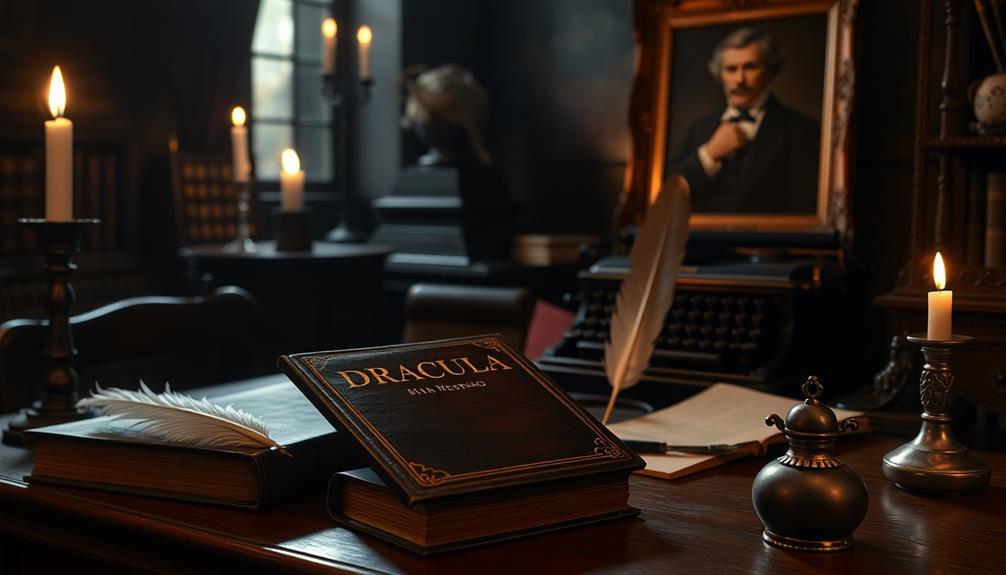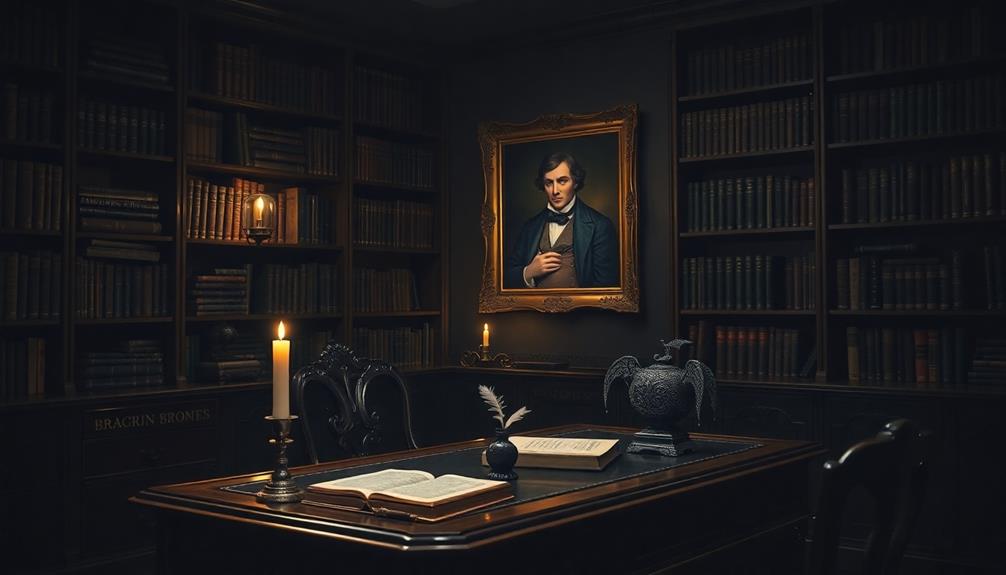You're curious about the author of *Dracula*, and that's Bram Stoker. Born on November 8, 1847, in Dublin, he faced health challenges early on but went on to study math at Trinity College. Stoker's career began as a drama critic before he published *Dracula* in 1897, a novel that solidified his status in gothic literature. Influenced by theater and folklore, he created an enchanting tale that reshaped horror fiction. Stoker's legacy endures, inspiring countless adaptations and analyses. If you look further, you'll uncover more fascinating details about his life and the timeless impact of *Dracula*.
Early Life and Education
Bram Stoker, born on November 8, 1847, in Clontarf, County Dublin, faced significant challenges early in life, including a serious illness that kept him from walking until he was seven. This illness shaped his early years, but it didn't deter his academic ambitions.
As he grew stronger, he excelled in his studies and became an outstanding athlete, demonstrating a resilience that echoes the stories of unsung contributions in science and technology. His education continued at Trinity College Dublin from 1864 to 1870, where he earned a degree in mathematics, showcasing his intellect and determination.
After graduation, Stoker entered the civil service at Dublin Castle, where he worked for ten years. Despite his stable job in this middle-class environment, his passion for writing and theater remained strong.
He served as an unpaid drama critic for the Dublin Evening Mail, which allowed him to immerse himself in the vibrant theater scene. This role not only honed his writing skills but also connected him with influential figures, including Sir Henry Irving.
These experiences during his early life and education laid the groundwork for Stoker's later literary pursuits, ultimately leading him to become the famous author of "Dracula."
Career and Literary Journey
During his career, Stoker navigated the worlds of drama and literature with remarkable skill, starting as an unpaid drama critic for the Dublin Evening Mail while working in civil service. His first published book, *The Duties of Clerks of Petty Sessions in Ireland*, released in 1879, marked the beginning of his writing journey. This early experience honed his literary voice and set the stage for future works, reflecting the enduring strength found in perseverance against poverty and adversity that resonates in many literary narratives.
Stoker's big break came with the publication of *Dracula* in 1897. This iconic novel, written in an innovative epistolary format, not only showcased his storytelling abilities but also profoundly influenced the portrayal of vampires in Western literature. Over his literary career, Stoker penned around 18 books, but none achieved the lasting impact of *Dracula*.
An essential part of his journey was his role at the Lyceum Theatre, where he managed the renowned actor Sir Henry Irving for 27 years. This position immersed him in theatrical storytelling, shaping his narrative style and enhancing his appreciation for the dramatic arts.
Through these experiences, Bram Stoker evolved into a formidable figure in literature, leaving a legacy that endures to this day.
Major Works and Contributions

Stoker's major works, particularly *Dracula*, solidified his status in Gothic literature and left a lasting mark on the genre. Published in 1897, *Dracula* is an epistolary novel that intricately weaves letters, diary entries, and newspaper articles to reveal Count Dracula's supernatural influence in England. This masterpiece not only established Bram Stoker as a significant literary figure but also transformed the portrayal of vampires in Western culture.
His storytelling prowess can be likened to the intricate plotting found in historical mystery novels that captivate readers with their rich detail and complex characters.
Throughout his career, Stoker authored around 18 novels, including *The Mystery of the Sea* (1902) and *The Jewel of Seven Stars* (1903). His extensive research into folklore and historical figures, particularly Vlad the Impaler, added depth and complexity to the characters and narratives in *Dracula*.
The supernatural elements he introduced, along with his distinctive writing style, have greatly influenced the Gothic genre and inspired countless adaptations.
Stoker's contributions continue to resonate, as his innovative approach to storytelling and character development has shaped the vampire mythos that dominates literature and film today. His works remain a reflection of his creativity and enduring impact on Gothic literature.
Influences and Inspirations
As you explore the influences behind *Dracula*, you'll find that Bram Stoker's literary inspirations played a significant role in shaping his narrative.
Historical figures like Vlad the Impaler and personal experiences with notable personalities enriched his storytelling.
The era in which Stoker wrote also reflects the ongoing struggles against tyranny and oppression, much like the acts of courage and defiance seen during World War II.
Together, these elements created a complex backdrop that fueled the chilling tale of Count Dracula.
Literary Influences on Stoker
Bram Stoker's *Dracula* is steeped in a rich tapestry of literary influences and inspirations that shaped its creation. Stoker drew heavily from Transylvanian folklore, weaving local legends into the narrative. The character of Count Dracula showcases potential influences from historical figures like Vlad the Impaler, though the connection isn't definitively proven.
His writing also reflects the cultural context of the Victorian era, tackling themes such as gender roles and sexuality. Stoker's engagement with contemporary literary trends is evident in his nod to the lesbian vampire trope, as seen in J. Sheridan Le Fanu's *Carmilla*. This connection highlights the fluidity of sexuality and desire, which was a growing concern during the period.
Additionally, Elizabeth Báthory, the notorious "Blood Countess," likely inspired some of Dracula's haunting imagery, paralleling her infamous cruelty with the vampiric traits of his character.
Historical Figures and Events
Count Dracula, the iconic figure at the center of Stoker's novel, is deeply rooted in historical figures and events that shaped the vampire mythos. Bram Stoker drew inspiration from Vlad the Impaler, a notorious 15th-century Romanian prince known for his brutal reign, although there's no definitive link between them.
Elizabeth Báthory, the infamous Hungarian noblewoman accused of torturing young girls, also influenced Dracula's character, particularly through her association with blood and violence.
Stoker's research into Transylvanian folklore enriched the supernatural elements of the novel, emphasizing the rich tapestry of vampires and other folkloric creatures. As you investigate the narrative, you'll notice how Count Dracula embodies the cultural anxieties of the Victorian era, especially regarding sexuality and gender roles.
Stoker navigated a world marked by fear of the outsider, and Dracula's character reflects that tension. Additionally, literary contemporaries like Sheridan Le Fanu, who introduced a lesbian vampire in his novella *Carmilla*, contributed to shaping Stoker's portrayal of vampiric themes.
These influences helped establish key tropes in the vampire mythos, allowing Stoker to explore complex societal issues within his gripping tale.
Personal Experiences and Relationships
Numerous personal experiences and relationships shaped Bram Stoker's worldview and, ultimately, his writing. Born into a middle-class Anglo-Irish family in 1847, Stoker faced health challenges early in life, which influenced his perspectives. His marriage to Florence Balcombe, who'd been courted by Oscar Wilde, connected him to prominent literary figures, enriching his social landscape.
One of the most significant influences on Stoker's life was his 27-year relationship with Sir Henry Irving. As Irving's manager at the Lyceum Theatre, Stoker immersed himself in the London theater scene, which became a foundation of his identity. This environment exposed him to powerful personalities and dramatic narratives that would later inform his work.
Stoker's admiration for figures like Walt Whitman and Abraham Lincoln also played an essential role in shaping his character development in *Dracula*. His interactions with luminaries like actress Ellen Terry further refined his understanding of complex relationships, directly impacting the dynamics within his writing.
These personal experiences and relationships not only enriched Stoker's biography but also provided fertile ground for the chilling themes and characters that define *Dracula*.
Cultural Impact of Dracula

The cultural impact of *Dracula* is undeniable, with its influence weaving through literature, film, and broader societal discussions. Published in 1897, Bram Stoker's novel reshaped the landscape of gothic fiction, establishing Count Dracula as a cultural icon. This character has become synonymous with the vampire genre, appearing in over 30 film adaptations that have greatly impacted the horror genre.
The haunting atmosphere of Stoker's work, much like the eerie ambiance of the haunting setting of Paris Opera, captivates readers and audiences alike. Stoker's *Dracula* introduced key tropes that have influenced countless writers and media representations. The themes explored in the novel, such as gender roles and sexuality, continue to resonate with modern audiences and scholars alike. You might find it fascinating how these themes spark discussions relevant to contemporary societal issues, demonstrating the book's lasting importance.
Count Dracula's character embodies the quintessential vampire, and his portrayal has set the standard for countless adaptations and parodies across various media.
The literary legacy of *Dracula* endures, inspiring countless interpretations and reinventions. As you immerse yourself in the world of vampires, it's clear that Stoker's work remains a cornerstone of the genre, influencing not just literature but the very fabric of popular culture.
Legacy and Recognition
Enduring fascination with Bram Stoker's *Dracula* highlights its legacy as a cornerstone of English literature. Published in 1897, the novel not only established key vampire tropes but also solidified Stoker's status as a pivotal figure in gothic horror. Its influence is immense, inspiring countless adaptations in film, theater, and literature, ensuring that *Dracula* remains a cultural touchstone.
Similar to the resilience depicted in *The Book Thief*, Stoker's work navigates themes of courage and the human spirit in the face of darkness, reminding readers of the power of storytelling in times of struggle. acts of defiance can be found woven throughout both narratives, enriching their respective themes.
Stoker's literary estate continues to manage his works, safeguarding his contributions for future generations. Through this oversight, his legacy thrives, allowing readers to explore not just *Dracula*, but also the eleven other novels and two short story collections he authored.
Scholars and critics analyze *Dracula* for its rich exploration of Victorian themes, such as gender roles, sexuality, and the anxieties of modernity, affirming its relevance in contemporary discussions on social issues.
With millions of copies sold worldwide, Stoker's recognition is undeniable. His influence reaches far beyond his most famous work, shaping the horror genre and inspiring writers and creators across various mediums.
In celebrating Stoker, we honor a literary giant whose impact endures through time.
Conclusion
You've just explored the fascinating life of Bram Stoker, the genius behind 'Dracula.' His early struggles and literary journey shaped a masterpiece that continues to captivate audiences today, much like how a trending Netflix series grabs viewers. Stoker's influences and the cultural impact of his work have solidified his legacy in the literary world. So, next time you binge-watch a vampire show, remember the man who started it all—Bram Stoker and his haunting tale.



